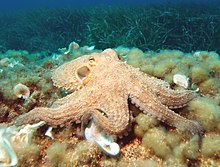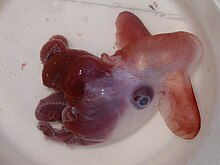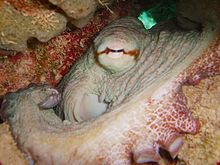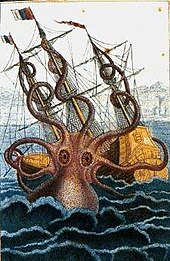New Link. Found 11/8/17
Octopus
| Octopus Temporal range: 323.2 – 0 Ma Late Carboniferous – recent | |
|---|---|
 | |
| Common octopus (Octopus vulgaris) | |
| Scientific classification | |
| Kingdom: | Animalia |
| Phylum: | Mollusca |
| Class: | Cephalopoda |
| Subclass: | Coleoidea |
| (unranked): | Neocoleoidea |
| Superorder: | Octopodiformes |
| Order: | Octopoda Leach, 1818[1] |
| Suborders | |
| Synonyms | |
| |
The octopus (/ˈɒktəpəs/ or ~/pʊs/ ) is a soft-bodied, eight-armed mollusc of the order Octopoda. Around 300 species are recognised and the order is grouped within the class Cephalopoda with squids, cuttlefish and nautiloids. Like other cephalopods, the octopus is bilaterally symmetric with two eyes and a beak, with its mouth at the centre point of the arms (which are sometimes mistakenly called "tentacles"). The soft body can rapidly alter its shape, enabling octopuses to squeeze through small gaps. They trail their eight arms behind them as they swim. The siphon is used both for respiration and for locomotion, by expelling a jet of water. Octopuses have a complex nervous system and excellent sight, and are among the most intelligent and behaviourally diverse of all invertebrates.
Octopuses inhabit various regions of the ocean, including coral reefs, pelagic waters, and the seabed; some live in the intertidal zone and others at abyssal depths. Most species grow fast, mature early and are short-lived. During breeding, the male uses a specially adapted arm to deliver a bundle of sperm directly into the female's mantle cavity, after which he becomes senescent and dies. The female deposits fertilised eggs in a den and cares for them until they hatch, after which she also dies.
Strategies to defend themselves against predators include the expulsion of ink, the use of camouflage and threat displays, their ability to jet quickly through the water, and their ability to hide. All octopuses are venomous, but only the blue-ringed octopuses are known to be deadly to humans.
Octopuses appear in mythology as sea monsters like the Kraken of Norway and the Akkorokamui of the Ainu, and probably the Gorgon of ancient Greece. A battle with an octopus appears in Victor Hugo's book Toilers of the Sea, inspiring other works such as Ian Fleming's Octopussy. Octopuses appear in Japanese erotic art, shunga. They are eaten by humans in many parts of the world, especially the Mediterranean and the Asian seas.
...
The interior surfaces of the arms are covered with circular, adhesive suckers. The suckers allow the octopus to anchor itself or to manipulate objects. Each sucker is usually circular and bowl-like and has two distinct parts: an outer shallow cavity called an infundibulum and a central hollow cavity called an acetabulum, both of which are thick muscles covered in a protective chitinous cuticle. When a sucker attaches to a surface, the orifice between the two structures is sealed. The infundibulum provides adhesion while the acetabulum remains free, and muscle contractions allow for attachment and detachment.[29][30]
The eyes of the octopus are large and are at the top of the head. They are similar in structure to those of a fish and are enclosed in a cartilaginous capsule fused to the cranium. The cornea is formed from a translucent epidermal layer and the slit-shaped pupilforms a hole in the iris and lies just behind. The lens is suspended behind the pupil and photoreceptive retinal cells cover the back of the eye. The pupil can be adjusted in size and a retinal pigment screens incident light in bright conditions.[22]
Some species differ in form from the typical octopus body shape. Members of the suborder Cirrina have stout gelatinous bodies with webbing that reaches near the tip of their arms, and two large fins above the eyes, supported by an internal shell. Fleshy papillae or cirri are found along the bottom of the arms, and the eyes are more developed.[31][32]
...
Nervous system and senses
The octopus (along with cuttlefish) has the highest brain-to-body mass ratios of all invertebrates, and is also greater than many vertebrates.[43] It has a highly complex nervous system, only part of which is localised in its brain, which is contained in a cartilaginous capsule.[44] Two-thirds of an octopus's neurons are found in the nerve cords of its arms, which show a variety of complex reflex actions that persist even when they have no input from the brain.[45] Unlike vertebrates, the complex motor skills of octopuses are not organised in their brain via an internal somatotopic map of its body, instead using a nonsomatotopic system unique to large-brained invertebrates.[46]
Octopuses have keen eyesight. Like other cephalopods, they can distinguish the polarisation of light. Colour visionappears to vary from species to species, for example being present in O. aegina but absent in O. vulgaris.[47] Attached to the brain are two special organs called statocysts(sac-like structures containing a mineralised mass and sensitive hairs), that allow the octopus to sense the orientation of its body. They provide information on the position of the body relative to gravity and can detect angular acceleration. An autonomic response keeps the octopus's eyes oriented so that the pupil is always horizontal.[22] Octopuses may also use the statocyst to hear sound. The common octopus can hear sounds between 400 Hz and 1000 Hz, and hears best at 600 Hz.[48]
Octopuses also have an excellent sense of touch. The octopus's suction cups are equipped with chemoreceptors so the octopus can taste what it touches. Octopus arms do not become tangled or stuck to each other because the sensors recognise octopus skin and prevent self-attachment.[49]
The arms contain tension sensors so the octopus knows whether its arms are stretched out, but this is not sufficient for the brain to determine the position of the octopus's body or arms. As a result, the octopus does not possess stereognosis; that is, it does not form a mental image of the overall shape of the object it is handling. It can detect local texture variations, but cannot integrate the information into a larger picture. The neurological autonomy of the arms means the octopus has great difficulty learning about the detailed effects of its motions. It has a poor proprioceptive sense, and it only knows what exact motions were made by observing the arms visually.[50]
Ink sac
The ink sac of an octopus is located under the digestive gland. A gland attached to the sac produces the ink, and the sac stores it. The sac is close enough to the funnel for the octopus to shoot out the ink with a water jet. Before it leaves the funnel, the ink passes through glands which mix it with mucus, creating a thick, dark blob which allows the animal to escape from a predator.[51] The main pigment in the ink is melanin, which gives it its black colour.[52] Cirrate octopuses lack the ink sac.[31]
....
Relationship to humans
Cultural references
Ancient seafaring people were aware of the octopus, as evidenced by certain artworks and designs. For example, a stone carving found in the archaeological recovery from Bronze Age Minoan Crete at Knossos (1900 – 1100 BC) has a depiction of a fisherman carrying an octopus.[120] The terrifyingly powerful Gorgon of Greek mythology has been thought to have been inspired by the octopus or squid, the octopus itself representing the severed head of Medusa, the beak as the protruding tongue and fangs, and its tentacles as the snakes.[121] The Kraken are legendary sea monsters of giant proportions said to dwell off the coasts of Norway and Greenland, usually portrayed in art as a giant octopus attacking ships. Linnaeus included it in the first edition of his 1735 Systema Naturae.[122][123] A Hawaiian creation myth says that the present cosmos is the last of a series which arose in stages from the ruins of the previous universe. In this account, the octopus is the lone survivor of the previous, alien universe.[124] The Akkorokamui is a gigantic octopus-like monster from Ainu folklore.[125]
A battle with an octopus plays a significant role in Victor Hugo's book Travailleurs de la mer (Toilers of the Sea), relating to his time in exile on Guernsey.[126] Ian Fleming's 1966 short story collection Octopussy and The Living Daylights, and the 1983 James Bond filmwere partly inspired by Hugo's book.[127]
Japanese erotic art, shunga, includes ukiyo-e woodblock prints such as Katsushika Hokusai's 1814 print Tako to ama (The Dream of the Fisherman's Wife), in which an ama diver is sexually intertwined with a large and a small octopus.[128][129] The print is a forerunner of tentacle erotica.[130] The biologist P. Z. Myers noted in his science blog, Pharyngula, that octopuses appear in "extraordinary" graphic illustrations involving women, tentacles, and bare breasts.[131][132]
Since it has numerous arms emanating from a common centre, the octopus is often used as a symbol for a powerful and manipulative organisation, usually negatively.[133]
Danger
Octopuses generally avoid humans, but incidents have been verified. For example, a 2.4-metre (8 ft) Pacific octopus, said to be nearly perfectly camouflaged, "lunged" at a diver and "wrangled" over his camera before it let go. Another diver recorded the encounter on video.[134]
All species are venomous, but only blue-ringed octopuses have venom that is lethal to humans.[135] Bites are reported each year across the animals' range from Australia to the eastern Indo-Pacific Ocean. They bite only when provoked or accidentally stepped upon; bites are small and usually painless. The venom appears to be able to penetrate the skin without a puncture, given prolonged contact. It contains tetrodotoxin, which causes paralysis by blocking the transmission of nerve impulses to the muscles. This causes death by respiratory failure leading to cerebral anoxia. No antidote is known, but if breathing can be kept going artificially, patients recover within 24 hours.[136][137] Bites have been recorded from captive octopuses of other species; they leave swellings which disappear in a day or two.[138]







No comments:
Post a Comment